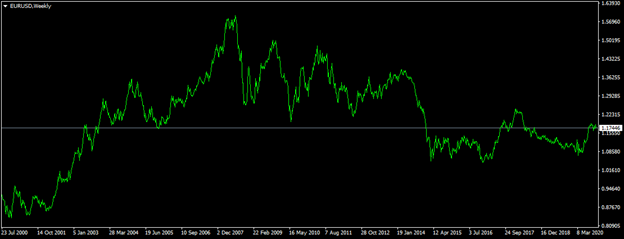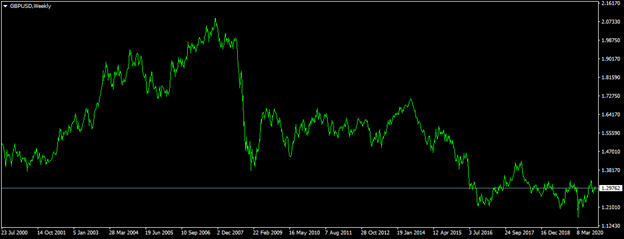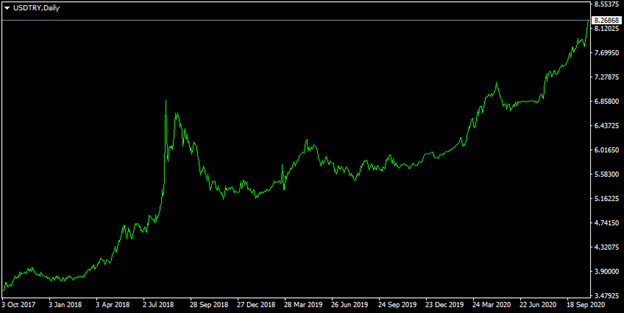One of the things many investors wonder about the Forex market is whether or not the US government follows a strong dollar policy and if it is so, then what implications can it have on the currency exchange rates, explains Konstantin Rabin of MiltonPrime Brokerage.
The strong dollar policy was actually announced by Robert Rubin, back in 1995, when he was the US Treasury Secretary at that time . During the subsequent years, his successors from time to time reaffirmed their stance that the United States supports a strong US dollar.
Now, one of the most obvious questions here is: what do they mean when they say that they support the strong US dollar? Well, the majority of people might interpret that as a commitment to support an appreciation of the US dollar against other currencies. However, this is not the only interpretation for the strong dollar policy. Another one, very frequently mentioned by some financial experts and commentators, is the commitment to keep the average inflation rate reasonably low and maintain the status of the US dollar as the world's number one reserve currency.
Impact of Strong Dollar Policy on the Forex Exchange Rates
Let us now consider each of those interpretations in greater detail in order to determine which one is closer to the realities on the ground. Firstly, we can begin with the assumption that the strong dollar policy means a commitment to support an appreciation of the US dollar against other currencies. Was this the case for the last 25 years? Well, in order to respond to this question, we can take a look at this weekly EUR/USD chart:

Now, it is worth mentioning that the euro was only officially introduced in 1999. Consequently, there was no single currency as we know it back in 1995, when the strong dollar policy was officially announced by the US Secretary of Treasury. However, fortunately there was a so-called European Currency Unit, also known as ECU, which essentially acted as a predecessor to the euro. So, if we use this as guidance, then we can conclude that during the middle of 1995 the EUR/USD pair exchange rate stood close to $1.35 level.
During the subsequent period, the US dollar has made some very impressive gains and even managed to breach the parity level by 2000. In fact, during 2001 the US currency was at the peak of its strength, with the EUR/USD trading close to $0.85 level. One of the main reasons for this was the fact that the interest rates in the United States were considerably higher than in the Eurozone.
For example, when the European Central Bank, also known as the ECB, started functioning at the beginning of 1999, the key interest rate for the single currency was at 3%. In sharp contrast to this policy, by 2000, the federal funds rate in the United States stood at 6.5%, which was 3.5% higher than in the Eurozone.
In addition to that it is also worth mentioning that from 1998 until 2001 the US had a budget surplus, which also played an important role in strengthening the US currency against other currencies.
So we can see that from 1995 until 2001, the policies of the US Federal Reserve and the US government in general was supportive of the strong US dollar. However, this approach has changed dramatically from 2002 until 2008.
As we can observe from the above diagram, during this six-year period, the US dollar depreciated considerably, with the EUR/USD rising from the $0.85 level to the all-time high of $1.59 during the summer of 2008. Obviously, this was not the case of the straight line rise of the euro. There were some major corrections along the way, especially during 2005, however the long-term upward trend of the EUR/USD pair is quite clear.
In fact, this depreciation of the US dollar was not only limited to the EUR/USD pair. For the purpose of comparison, we can also take a look at this daily GBP/USD chart:

Here we can see that in 2000, the GBP/USD pair was trading close to the $1.40 level and remained broadly subdued during 2001 as well. However, from 2002, the British currency began to make some steady gains against the US dollar. This upward trend for the British pound has persisted until the summer of 2008. At that time, the GBP/USD pair has risen all the way up to the $2.00 level.
This long-term downward trend for the US dollar came to an end during August 2008, as there was a sharp reversal in the case of the EUR/USD exchange rate. Before the end of the year, the EUR/USD exchange rate was already near the $1.30 mark. During the subsequent years, there was a high degree of volatility for this currency pair. However, one thing we can notice on the chart is the fact that the highs were getting lower at the time, pointing at the downward channel, which persisted at least until the Spring 2020, with the EUR/USD pair falling all the way down to the $1.06 level.
It is true that since then the euro has managed to have a relief rally, with the EUR/USD pair rising to the $1.18 level. However, it is still too early to call for an end for the long-term downward trend for the EUR/USD exchange rate. After all, the price has not yet broken above the long-term downward channel.
We also have a very similar situation with the GBP/USD pair. Before the end of 2008, the price had collapsed from the $2.00 level to all the way down to the $1.40 mark. Just like in the case of the EUR/USD pair, this was followed by a considerable amount of volatility, however, after the 2016 European Union membership referendum, the GBP/USD pair has simply resumed its downward trend and by March 2020, fell all the way down to the $1.15 level.
During the subsequent period, the British pound had a relief rally and the GBP/USD pair recovered to the $1.30 level. However, just like in the case of the EUR/USD pair, the long-term downward trend so far remains intact.
Major vs. Exotic Currencies
As we have seen so far, the strength of the US dollar was very much a cyclical phenomenon. In fact, there were long periods of time where the American currency has made some massive gains against the other major currencies. This was followed by extended periods of USD weakness, only to be substituted by yet another period of the USD strength.
However, those trends mostly apply to the major currencies. The reality of the matter is that the US dollar is in a permanent upward trend against some of the emerging market currencies. This can happen for a variety of reasons ranging from the economic and political instability to the inflation rate differentials.
In order to illustrate one example of this, we can take a look at this daily USD/TRY chart:

As we can observe from the above diagram, three years ago, the USD/TRY pair was trading close to the 3.55 level. During the subsequent years, the US dollar has made some notable gains, eventually rising all the way up to the 7.10 level. This was followed by sharp correction, with the exchange rate returning to the 5.25 level.
However, despite the recovery of the lira exchange rate, this did not stop the long-term appreciation of the US dollar against the Turkish currency. During the subsequent period, the USD/TRY has resumed its upward trend and by October 2020 have reached the 8.26 level. This means that during this three-year period, the US dollar has appreciated by approximately 133%, which is very impressive.
One of the main reasons for this is the inflation rate differentials between two currencies. For decades the Turkish lira suffered from considerably high inflation rates, with the average CPI exceeding 10% on an annual basis. On the other hand, the US dollar has a long-term average inflation rate close to 3%. This made the US dollar a much better store of value than the Turkish currency, leading to the long-term appreciation of the USD/TRY exchange rate.
Meaning of the Strong Dollar Policy
After going through all of those analyses we can come up with several conclusions. Firstly, it seems obvious that what the US Treasury officials mean by the “strong dollar policy” is maintaining the price stability with low inflation rates and protecting the status of the US dollar as the world's reserve currency.
By those statements, they do not mean that the US government and US Federal Reserve will actively try to strengthen the US dollar against other currencies. However, by achieving its mandate of price stability, the US Federal Reserve ensures that the US dollar does appreciate consistently against some of the emerging market currencies. This is not the goal of the US policymakers, but this is essentially a side effect of maintaining the low inflation rates over an extended period of time.
However, when it comes to the major currencies it is a completely different story. Here we are clearly dealing with a cyclical trend, where currencies are typically engaged in multi-year uptrends and downtrends.
On the other hand, if the US government wanted to achieve a steady appreciation of the US dollar against other currencies, this is an achievable goal. Just like during the late 1990s, the combination of higher interest rates and lower budget deficits can give a strong boost to the US dollar.
Actually, nowadays it is easier to achieve than 25 years ago. This is simply because nowadays all major central banks are following very dovish policy, with interest rates at 0.25% or even lower. In fact, some central banks like the Bank of Japan and the Swiss National Bank have adopted the policy of negative interest rates, with all of its resulting unintended consequences.
However, at this point it is worth mentioning that a strong dollar does not only have advantages but also some disadvantages as well. On the positive side, the strong US dollar makes the cost of imported goods, services, and raw materials much cheaper for the American businesses and households.
Yet, on the other hand, the strong US dollar makes the cost of American goods and services much more expensive for foreigners. This obviously can result in the loss of competitiveness and worsening of the trade balance. In addition to that the strong US dollar can create a substantial headwind to the multinational US corporations, which derive a significant portion of their income from other countries.
This is because the reporting currency for those US corporations is USD. Consequently, they can see their earnings stagnate and can have a very hard time improving their profitability and increasing dividends to shareholders on a regular basis.
Finally, persistently appreciating US dollar will make it much less affordable for foreign investors to invest in US bonds, stocks, mutual funds, real estate, and other types of investments. This can reduce direct investment from abroad in the US markets. This can also create potential problems for US public finances as well. The fact of the matter is that approximately 1/3 of US bonds are purchased and owned by foreign governments, organizations, and individuals. Consequently, if those securities become unaffordable for foreigners that can potentially lead to the collapse of the bond market and higher interest rates on public debts.
Due to all those reasons, the US government and US Federal Reserve do not intervene in the forex market or adopt some specific policies in order to strengthen the exchange rate of the US dollar against other major currencies. However, the US Federal Reserve does work to keep the inflation rate low and maintain the price stability.
By Konstantin Rabin, Content Editor at Elite CurrenSea blog.





















